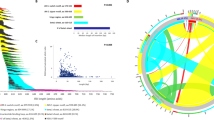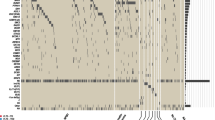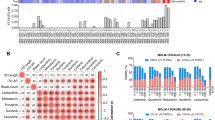Abstract
Effective targeted cancer therapeutic development depends upon distinguishing disease-associated ‘driver’ mutations, which have causative roles in malignancy pathogenesis, from ‘passenger’ mutations, which are dispensable for cancer initiation and maintenance. Translational studies of clinically active targeted therapeutics can definitively discriminate driver from passenger lesions and provide valuable insights into human cancer biology. Activating internal tandem duplication (ITD) mutations in FLT3 (FLT3-ITD) are detected in approximately 20% of acute myeloid leukaemia (AML) patients and are associated with a poor prognosis1. Abundant scientific2 and clinical evidence1,3, including the lack of convincing clinical activity of early FLT3 inhibitors4,5, suggests that FLT3-ITD probably represents a passenger lesion. Here we report point mutations at three residues within the kinase domain of FLT3-ITD that confer substantial in vitro resistance to AC220 (quizartinib), an active investigational inhibitor of FLT3, KIT, PDGFRA, PDGFRB and RET6,7; evolution of AC220-resistant substitutions at two of these amino acid positions was observed in eight of eight FLT3-ITD-positive AML patients with acquired resistance to AC220. Our findings demonstrate that FLT3-ITD can represent a driver lesion and valid therapeutic target in human AML. AC220-resistant FLT3 kinase domain mutants represent high-value targets for future FLT3 inhibitor development efforts.
This is a preview of subscription content, access via your institution
Access options
Subscribe to this journal
Receive 51 print issues and online access
$199.00 per year
only $3.90 per issue
Buy this article
- Purchase on Springer Link
- Instant access to full article PDF
Prices may be subject to local taxes which are calculated during checkout


Similar content being viewed by others
Accession codes
Primary accessions
Sequence Read Archive
Data deposits
SMRT sequencing data is deposited online at http:// www.ncbi.nlm.nih.gov/sra under accession number SRA050226.1.
References
Thiede, C. et al. Analysis of FLT3-activating mutations in 979 patients with acute myelogenous leukemia: association with FAB subtypes and identification of subgroups with poor prognosis. Blood 99, 4326–4335 (2002)
Lee, B. H. et al. FLT3 internal tandem duplication mutations induce myeloproliferative or lymphoid disease in a transgenic mouse model. Oncogene 24, 7882–7892 (2005)
Shih, L. Y. et al. Acquisition of FLT3 or N-ras mutations is frequently associated with progression of myelodysplastic syndrome to acute myeloid leukemia. Leukemia 18, 466–475 (2004)
Knapper, S. et al. A phase 2 trial of the FLT3 inhibitor lestaurtinib (CEP701) as first-line treatment for older patients with acute myeloid leukemia not considered fit for intensive chemotherapy. Blood 108, 3262–3270 (2006)
Fischer, T. et al. Phase IIB trial of oral Midostaurin (PKC412), the FMS-like tyrosine kinase 3 receptor (FLT3) and multi-targeted kinase inhibitor, in patients with acute myeloid leukemia and high-risk myelodysplastic syndrome with either wild-type or mutated FLT3. J. Clin. Oncol. 28, 4339–4345 (2010)
Zarrinkar, P. P. et al. AC220 is a uniquely potent and selective inhibitor of FLT3 for the treatment of acute myeloid leukemia (AML). Blood 114, 2984–2992 (2009)
Cortes, J. et al. in 16th Congress of the European Hematology Association (Haematologica, 2011)
Heidel, F. et al. Clinical resistance to the kinase inhibitor PKC412 in acute myeloid leukemia by mutation of Asn-676 in the FLT3 tyrosine kinase domain. Blood 107, 293–300 (2006)
Metzelder, S. et al. Compassionate use of sorafenib in FLT3-ITD-positive acute myeloid leukemia: sustained regression before and after allogeneic stem cell transplantation. Blood 113, 6567–6571 (2009)
Scholl, S. et al. Secondary resistance to sorafenib in two patients with acute myeloid leukemia (AML) harboring FLT3-ITD mutations. Ann. Hematol. 90, 473–475 (2011)
Azam, M., Latek, R. R. & Daley, G. Q. Mechanisms of autoinhibition and STI-571/imatinib resistance revealed by mutagenesis of BCR-ABL. Cell 112, 831–843 (2003)
Shah, N. P. et al. Multiple BCR-ABL kinase domain mutations confer polyclonal resistance to the tyrosine kinase inhibitor imatinib (STI571) in chronic phase and blast crisis chronic myeloid leukemia. Cancer Cell 2, 117–125 (2002)
Travers, K. J., Chin, C. S., Rank, D. R., Eid, J. S. & Turner, S. W. A flexible and efficient template format for circular consensus sequencing and SNP detection. Nucleic Acids Res. 38, e159 (2010)
Griffith, J. et al. The structural basis for autoinhibition of FLT3 by the juxtamembrane domain. Mol. Cell 13, 169–178 (2004)
Levinson, N. M. et al. A Src-like inactive conformation in the Abl tyrosine kinase domain. PLoS Biol. 4, e144 (2006)
Mol, C. D. et al. Structural basis for the autoinhibition and STI-571 inhibition of c-Kit tyrosine kinase. J. Biol. Chem. 279, 31655–31663 (2004)
Hubbard, S. R., Wei, L., Ellis, L. & Hendrickson, W. A. Crystal structure of the tyrosine kinase domain of the human insulin receptor. Nature 372, 746–754 (1994)
Mol, C. D. et al. Structure of a c-Kit product complex reveals the basis for kinase transactivation. J. Biol. Chem. 278, 31461–31464 (2003)
Hubbard, S. R. Crystal structure of the activated insulin receptor tyrosine kinase in complex with peptide substrate and ATP analog. EMBO J. 16, 5572–5581 (1997)
Wodicka, L. M. et al. Activation state-dependent binding of small molecule kinase inhibitors: structural insights from biochemistry. Chem. Biol. 17, 1241–1249 (2010)
Burley, S. K. & Petsko, G. A. Aromatic-aromatic interaction: a mechanism of protein structure stabilization. Science 229, 23–28 (1985)
Wan, P. T. et al. Mechanism of activation of the RAF-ERK signaling pathway by oncogenic mutations of B-RAF. Cell 116, 855–867 (2004)
Choudhary, C. et al. Activation mechanisms of STAT5 by oncogenic Flt3-ITD. Blood 110, 370–374 (2007)
Pao, W. et al. Acquired resistance of lung adenocarcinomas to gefitinib or erlotinib is associated with a second mutation in the EGFR kinase domain. PLoS Med. 2, e73 (2005)
Barbie, D. A. & Deangelo, D. J. Systemic mastocytosis: current classification and novel therapeutic options. Clin. Adv. Hematol. Oncol. 4, 768–775 (2006)
Anderson, K. et al. Genetic variegation of clonal architecture and propagating cells in leukaemia. Nature 469, 356–361 (2011)
Kralovics, R. et al. Acquisition of the V617F mutation of JAK2 is a late genetic event in a subset of patients with myeloproliferative disorders. Blood 108, 1377–1380 (2006)
Nazarian, R. et al. Melanomas acquire resistance to B-RAF(V600E) inhibition by RTK or N-RAS upregulation. Nature 468, 973–977 (2010)
Benson, G. Tandem repeats finder: a program to analyze DNA sequences. Nucleic Acids Res. 27, 573–580 (1999)
Yates, F. Tests of significance for 2 × 2 contingency tables. J. R. Stat. Soc. A 147, 426–463 (1984)
Barnard, G. A. Must clinical trials be large? The interpretation of p-values and the combination of test results. Stat. Med. 9, 601–614 (1990)
Morris, G. M. et al. AutoDock4 and AutoDockTools4: automated docking with selective receptor flexibility. J. Comput. Chem. 30, 2785–2791 (2009)
Schüttelkopf, A. W. & van Aalten, D. M. PRODRG: a tool for high-throughput crystallography of protein-ligand complexes. Acta Crystallogr. D 60, 1355–1363 (2004)
Acknowledgements
We thank K. Lin for technical assistance. This work was funded by grants from the Leukemia and Lymphoma Society (to C.C.S. and N.P.S.), the Doris Duke Charitable Foundation (to N.P.S.), NCI Leukemia SPORE P50 CA100632-06 (to M.J.L.), NCI R01 CA12886 (to M.J.L.) and the NIH T-32 Molecular Mechanisms of Cancer (to C.C.S.). C.C.S. would like to acknowledge the EHA/ASH Translational Research Training Institute. N.P.S. would like to thank Art and Alison Kern and the Edward S. Ageno family for their support.
Author information
Authors and Affiliations
Contributions
C.C.S., Q.W., C.-S.C., K.J.T., A.K., E.E.S. and J.K. designed experiments, performed research, analysed data and wrote the manuscript. N.P.S. designed experiments, analysed data and wrote the manuscript. L.E.D., S.W., J.P.H. and S.S. performed experiments and reviewed the manuscript. P.P.Z. was involved in study design and reviewed the manuscript. A.E.P. and M.J.L. provided reagents, performed research and reviewed the manuscript.
Corresponding author
Ethics declarations
Competing interests
The following authors declare competing financial interests: C.C.S. (consultancy, Astellas Pharma); M.J.L. (consultancy, Ambit Biosciences); J.P.H. and P.P.Z. (employment, Ambit Biosciences) E.E.S. and A.K. (equity ownership and employment, Pacific Biosciences); C.-S.C., K.J.T. and S.W. (employment, Pacific Biosciences).
Supplementary information
Supplementary Information
This file contains Supplementary Figures 1-6 and Supplementary Tables 1-5. (PDF 1527 kb)
PowerPoint slides
Rights and permissions
About this article
Cite this article
Smith, C., Wang, Q., Chin, CS. et al. Validation of ITD mutations in FLT3 as a therapeutic target in human acute myeloid leukaemia. Nature 485, 260–263 (2012). https://doi.org/10.1038/nature11016
Received:
Accepted:
Published:
Issue Date:
DOI: https://doi.org/10.1038/nature11016
This article is cited by
-
Sitravatinib as a potent FLT3 inhibitor can overcome gilteritinib resistance in acute myeloid leukemia
Biomarker Research (2023)
-
GNF-7, a novel FLT3 inhibitor, overcomes drug resistance for the treatment of FLT3‑ITD acute myeloid leukemia
Cancer Cell International (2023)
-
Targeting C/EBPα overcomes primary resistance and improves the efficacy of FLT3 inhibitors in acute myeloid leukaemia
Nature Communications (2023)
-
Blockade of de novo pyrimidine biosynthesis triggers autophagic degradation of oncoprotein FLT3-ITD in acute myeloid leukemia
Oncogene (2023)
-
Perspectives and challenges of small molecule inhibitor therapy for FLT3-mutated acute myeloid leukemia
Annals of Hematology (2023)
Comments
By submitting a comment you agree to abide by our Terms and Community Guidelines. If you find something abusive or that does not comply with our terms or guidelines please flag it as inappropriate.



